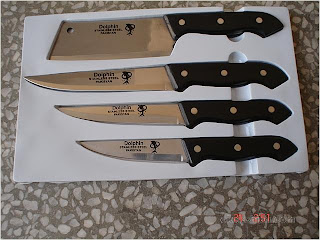With some know-how and practice, a kitchen knife can be your best friend during food preparation, or it can be a potential source of serious injury. Depending on your skill and what you already know about knife safety, it's always a good idea to hone knife safety skills. The first step in kitchen knife safety is purchasing the most quality set of knives you can afford. Avoid sets that have gaps at the joint – where the blade and handle meet. Quality knives should feel heavy and solid in your hand. And most importantly, take the time to learn how to use the knives and care for them.
There are five basic types of kitchen knives:
Chef's Knife
A chef's knife is typically the largest knife in the kitchen, with a wide blade that is eight to 10 inches in length. For the best wear and stability, the knife should have a full tang. In another words, the blade should go all the way through the handle. The chef's knife is one of the most important tools you can own when it comes to cooking. It can be used for slicing, chopping, dicing, mincing, julienne cuts, disjointing large cuts of meat, and even smashing garlic.





No comments:
Post a Comment